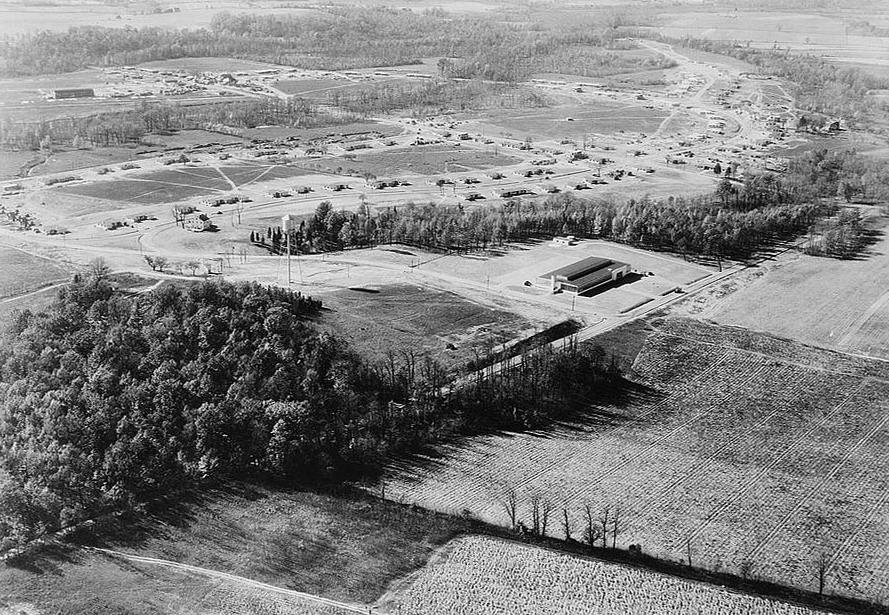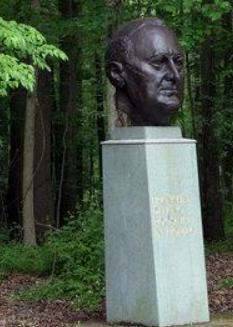During the dark, desperate days of the Great
Depression, the government selected Central Jersey
as the site of a bold, unprecedented experiment in
stimulus spending. With
the jobless rate hovering near 25 percent, dozens of
emergency anti-poverty initiatives were introduced
through various New Deal agencies.
Originally known as Jersey Homesteads, Roosevelt was
one of ninety-nine communities across the country
created by the federal government as part of a New
Deal initiative. In early 1933, the National
Industrial Recovery Act (NIRA) created the Division
of Subsistence Homesteads, the purpose of which was
to decentralize industry from congested cities and
enable workers to improve their standards of living
through the help of subsistence agriculture.
Jersey Homesteads was unique, however, in that
it was the only community planned as an
agro-industrial cooperative which included a farm,
factory and retail stores, and it was the only one
established specifically for urban Jewish garment
workers from New York, many of whom were committed
socialists.
Incorporated on May 29, 1937, the settlement was
like an American kibbutz, the countryís first and
only secular Jewish commune funded by US
government.

|
The land for the community is
located in Millstone Township, Monmouth
County, New Jersey (not far from
Hightstown).
The organizers took applications for 200
settlers at $500 to buy into the
co-operative community.
Five hundred acres of the 1,200 acre
tract were to be used for farming, and
the remaining portion for 200 houses on
1/2 acre plots, a community school, a
factory building, a poultry yard and
modern water and sewer plants.
Jersey Homesteads' buildings are
characterized by their spare geometric
forms and use of modern building
materials (including cinder blocks).
The houses are integrated with
communal areas and surrounded by a
green belt.
This is a view of Jersey Homesteads in
the 1930s.
|
International
Ladies' Garment Workers Union agreed that
the Jersey Homesteads factory would be a new
cooperative run by the settlers themselves,
so that no union jobs would be removed from
New York. The factory opened in 1936.
The Workers' Aim Cooperative Association had
overall responsibility for the factory: the
trade name for its products was Tripod,
signifying the triple cooperative (factory,
farm and retail stores).
The retail stores--a clothing store, grocery
and meat market, and tea room--were run by
the Jersey Homesteads Consumers' Cooperative
Association.
The garment factory failed within two years.
Because of delays in housing construction
and the resulting shortage of workers, the
first year was disappointing. The
workers actually went on strike at one
point, even though they owned the factory
and there was no upper management to
protest. They had gone on strike against
themselves, picketing their own
company. The factory was declared a
failure in 1939 by the Farm Security
Administration which attempted to auction
off the assets.
By early 1940, having failed to auction the
factory fixtures, negotiations with
Kartiganer and Co. succeeded and the company
began operations at the Jersey Homesteads
factory. Proving to be no more economically
successful than the factory, the
settlement's agricultural cooperative ceased
operations in 1940. Although the clothing
store failed with the factory, the borough's
cooperative grocery and meat market endured
into the 1940s.
|
The farm, consisting of general, poultry
and dairy units, was known as the Jersey
Homesteads Agricultural Association, and,
like the other cooperatives, was run by a
board of directors.
With a shortage of
green thumbs within the community, the
crops wilted. The former city dwellers
didnít till the soil enthusiastically.
|
Despite
conflicts and hardships, the residents of
the borough did manage to build a
close-knit community--working, playing and
developing the land together. Indeed, in
the late 1930s the Community Manager,
through the Works Progress Administration
(WPA), developed recreational programs of
adult education, arts and crafts, and
founded a library. The borough also had
many clubs and societies.
The Orthodox synagogue (Congregation
Anshei Roosevelt, later affiliated with
Conservative Judaism) did not seem to be
of central importance but religious
services were held at various locations
until a synagogue was built in 1956. Many
of the homesteaders spoke Yiddish and, in
general, all nurtured the community.
|

|
Artist Colony
In 1936, the artist Ben Shahn was invited to
paint a mural on the wall of the school
depicting the founding of Jersey Homesteads.
Ben Shahn and his wife Bernarda Bryson
settled permanently in Roosevelt in 1939 and
attracted other artists, including former
chairman of the Pratt Institute's Fine Arts
department Jacob Landau; painter Gregorio
Prestopino and his wife artist Liz Dauber;
graphic artist David Stone Martin and his
son wood engraver Stefan Martin;
photographers Edwin and Louise Rosskam; and
others.
Additional artists associated with Roosevelt
are pianists Anita Cervantes and Laurie
Altman, opera singer Joshua Hecht and
writers Benjamin Appel, Shan Ellentuck and
Franklin Folsom.
It was Ben Shahn who had the original idea
to build a monument to Franklin D. Roosevelt
in 1945. In 1960, on the eve of the
borough's 25th anniversary, a new Roosevelt
Memorial Committee was formed which was
able, through fund-raising and donated
labor, to create a memorial to the man who
was seen as the town's inspiration. Ben
Shahn's son Jonathan sculpted a bust of the
president.
|

|
Borough
of Roosevelt Historical Collection - Rutgers
University Library
|



